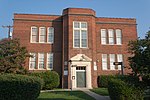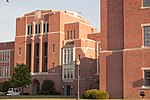Baltimore City College

Baltimore City College, known colloquially as City, City College, and B.C.C., is a college preparatory school with a liberal arts focus and selective admissions criteria located in Baltimore, Maryland. Opened in October 1839, B.C.C. is the third-oldest active public high school in the United States. City College is a public exam school and an International Baccalaureate World School at which students in the ninth and tenth grades participate in the IB Middle Years Programme while students in the eleventh and twelfth grades participate in the IB Diploma Programme.The school is situated on a 38 acres (0.15 km2) hill-top campus located in the Coldstream-Homestead-Montebello neighborhood in Northeast Baltimore. The main campus building, a designated National Historic Landmark, is constructed of granite and limestone in a Collegiate Gothic architectural style and features a 200-foot-tall Gothic tower.
Excerpt from the Wikipedia article Baltimore City College (License: CC BY-SA 3.0, Authors, Images).Baltimore City College
The Alameda, Baltimore
Geographical coordinates (GPS) Address Nearby Places Show on map
Geographical coordinates (GPS)
| Latitude | Longitude |
|---|---|
| N 39.325663 ° | E -76.597338 ° |
Address
Baltimore City College
The Alameda 3220
21218 Baltimore
Maryland, United States
Open on Google Maps







